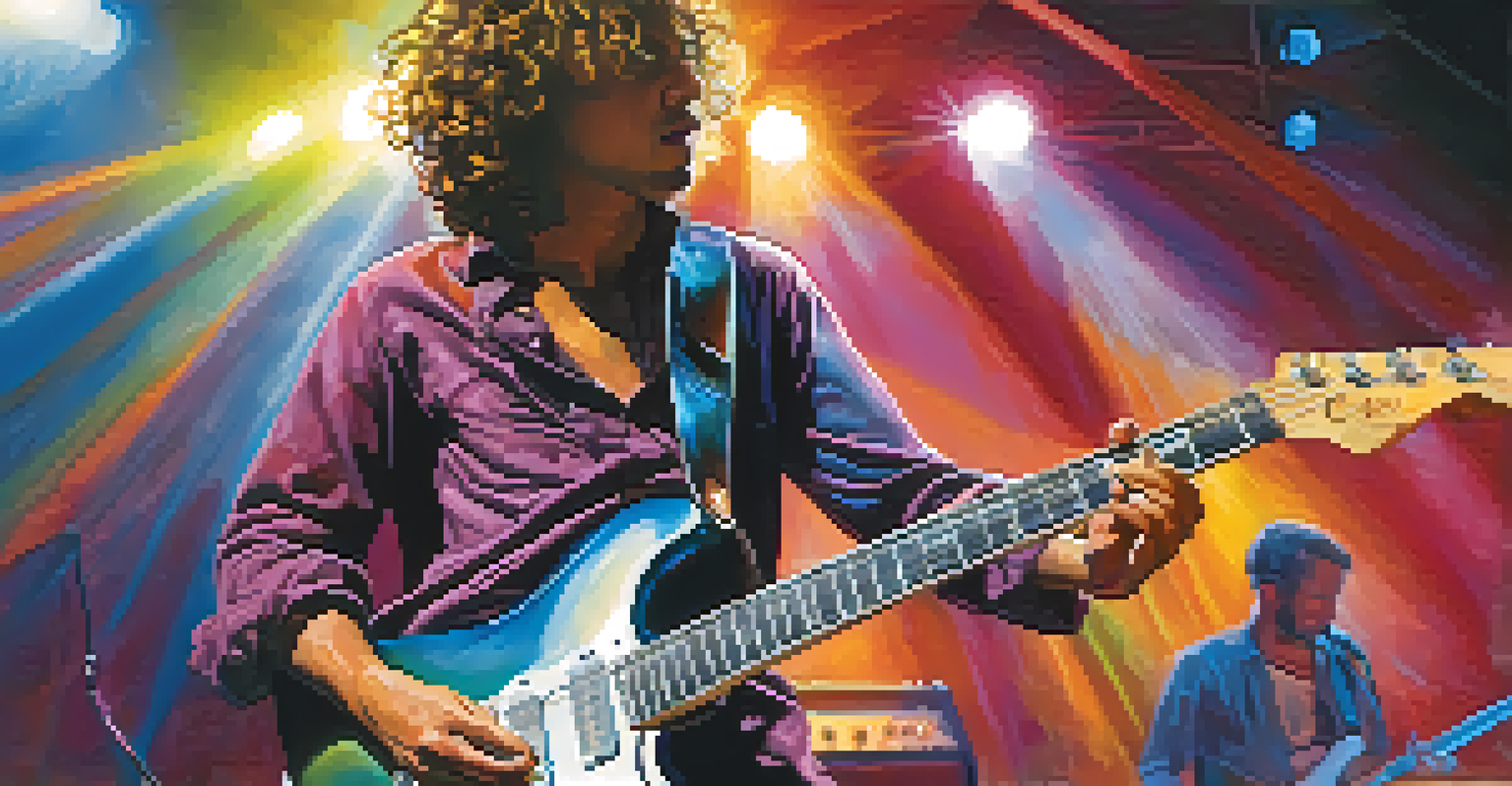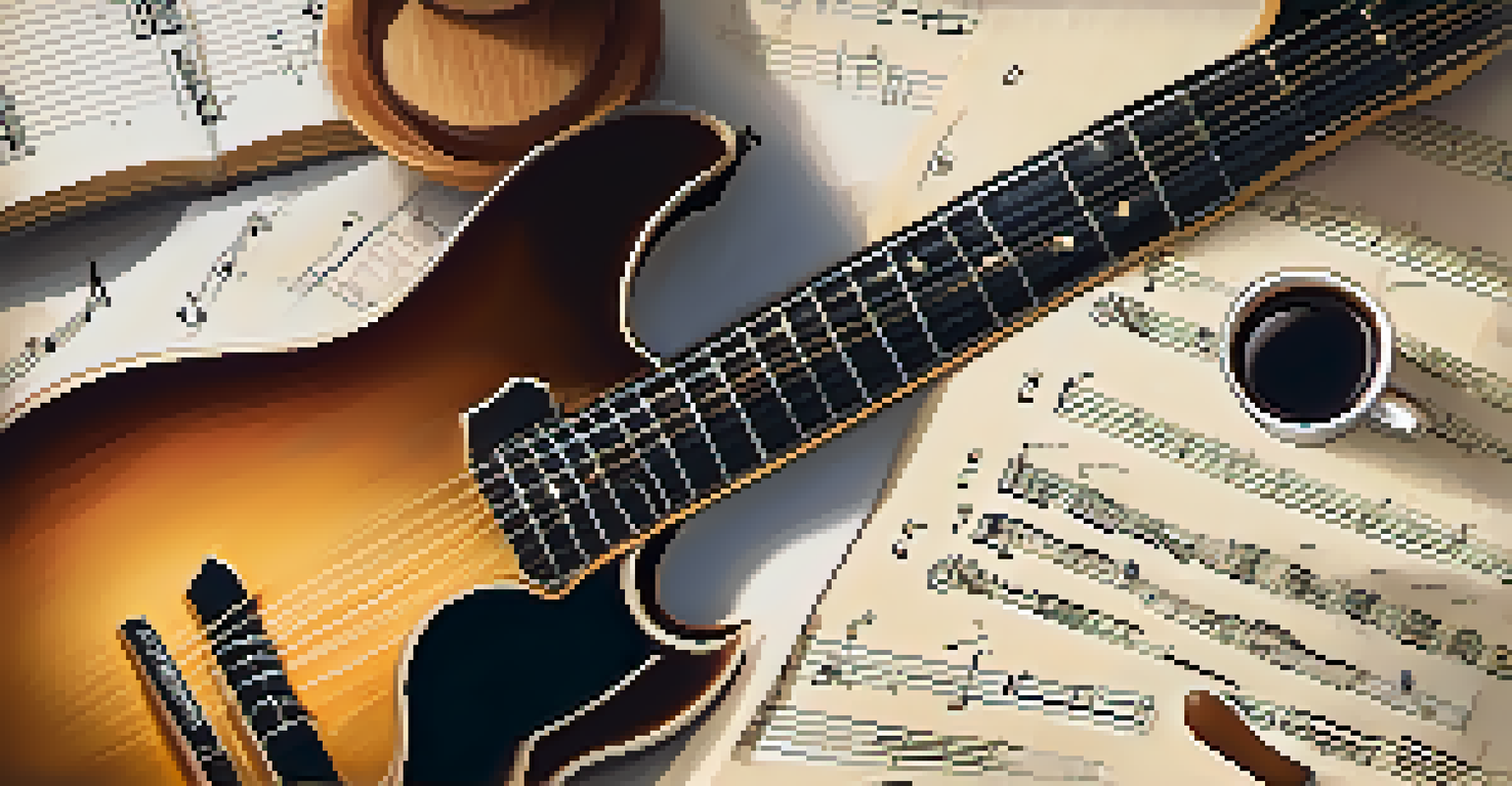Exploring Arpeggios for Creative Guitar Improvisation

Understanding Arpeggios: The Basics for Guitarists
Arpeggios are essentially broken chords, where the notes of a chord are played in succession rather than simultaneously. This technique can add depth and texture to your playing, making it an essential tool for any guitarist. Imagine playing a C major chord; instead of strumming all the strings at once, you pick them one at a time, creating a flowing sound that’s both melodic and harmonious.
Music is the shorthand of emotion.
By mastering arpeggios, you can enhance your improvisational skills, allowing you to craft solos that resonate with emotion and creativity. They can be used in various music genres, from classical to rock, making them versatile tools in your musical toolkit. Think of arpeggios as the building blocks of your guitar solos, providing a framework that supports your improvisation.
As you become more familiar with arpeggios, you'll start to notice how they can seamlessly fit into your existing playing style. This understanding opens up a world of possibilities for expression and experimentation in your music. So, let’s dive deeper into how you can use arpeggios for your creative guitar improvisation!
The Role of Arpeggios in Improvisation
When it comes to improvisation, arpeggios serve as a guide to navigating chord progressions. They help you outline the harmonic structure of a song, allowing you to create solos that are not only interesting but also musically coherent. Picture yourself jamming with a band; using arpeggios can help you stay aligned with the underlying chords, making your playing feel more integrated.

Moreover, arpeggios can add a sense of movement to your improvisation. By varying the rhythm and speed at which you play these notes, you can create tension and release, captivating your audience. Think of a painter using different brush strokes to add depth to a canvas; arpeggios can bring that same vibrant energy to your solos.
Arpeggios Enhance Guitar Solos
Mastering arpeggios allows guitarists to add depth and creativity to their solos, making their playing more expressive.
Incorporating arpeggios into your improvisation not only enhances your musical phrases but also showcases your technical skills. As you experiment with different arpeggio shapes and patterns, you’ll discover new ways to express your musical ideas, leading to more dynamic performances.
Exploring Different Arpeggio Shapes and Patterns
There’s a vast array of arpeggio shapes you can explore, each offering unique sonic possibilities. Common shapes include major, minor, and seventh arpeggios, but you can also experiment with extended and altered chords for added flavor. Visualize these shapes on the fretboard; the more you familiarize yourself with them, the easier it becomes to incorporate them into your playing.
The beautiful thing about learning is that no one can take it away from you.
For instance, a simple C major arpeggio consists of the notes C, E, and G, but you can play these notes in various octaves or positions on the guitar. By practicing different fingerings and sequences, you’ll not only increase your dexterity but also expand your musical vocabulary. It’s like having a toolbox filled with various instruments for different tasks.
As you get comfortable with these shapes, challenge yourself to combine them or create your own patterns. This exploration can lead to exciting discoveries in your improvisational playing, making your solos more distinct and personal. Remember, the goal is to make these arpeggios your own!
Creating Melodic Lines with Arpeggios
One of the most powerful uses of arpeggios is their ability to create melodic lines that stand out. When you play arpeggios, you’re essentially outlining the melody of the underlying chord progression, which can make your solos sound more cohesive. Think of your favorite guitar solos; many of them likely incorporate arpeggios to emphasize the melody.
To craft a memorable melodic line, try starting your phrases with an arpeggio before adding other notes, like scale tones. This technique allows you to anchor your improvisation while adding embellishments for variation. Picture a sculptor chiseling away at a block of marble; the arpeggio serves as the solid base from which your intricate solo emerges.
Key to Improvisational Coherence
Arpeggios help outline chord progressions, guiding guitarists to create coherent and engaging improvisations.
Additionally, by varying the rhythm and dynamics of your arpeggios, you can evoke different emotions in your playing. A slow, deliberate arpeggio can convey a sense of longing, while a fast, staccato approach might exude excitement. Experimenting with these elements can transform your solos into compelling musical stories.
Incorporating Arpeggios into Your Practice Routine
To make the most of arpeggios in your improvisation, it’s essential to incorporate them into your daily practice routine. Start by dedicating specific time to work on different arpeggio shapes and patterns. Just like athletes train for peak performance, consistent practice will help you build muscle memory and improve your technical skills on the guitar.
A great way to practice is to choose a chord progression and play corresponding arpeggios over it. This exercise not only reinforces your understanding of how arpeggios fit within a harmonic context but also boosts your improvisational confidence. Consider it a musical workout session that strengthens your abilities and prepares you for spontaneous jamming.
As you progress, challenge yourself to improvise using arpeggios in various musical contexts. You can set up backing tracks or play along with your favorite songs, incorporating arpeggios into your solos. This real-world application will help solidify your understanding and encourage creativity as you explore new musical landscapes.
Listening to Great Guitarists: Finding Inspiration
One of the best ways to deepen your understanding of arpeggios is to listen to guitarists who excel at using them in their improvisation. Artists like Joe Satriani, Steve Vai, and Eric Johnson are known for their innovative use of arpeggios, often weaving complex patterns into their solos. By immersing yourself in their music, you can gain insights into how they structure their phrases and create memorable lines.
Take the time to analyze their solos by transcribing sections that resonate with you. Pay close attention to how they blend arpeggios with other techniques, such as bends, slides, and hammer-ons. This exercise will not only sharpen your ear but also provide you with a treasure trove of ideas to incorporate into your playing.
Practice for Unique Style Development
Incorporating arpeggios into your practice routine not only improves technical skills but also fosters the development of a personal playing style.
Remember, inspiration can come from various genres, so don’t hesitate to explore beyond the rock guitar greats. Jazz, classical, and blues musicians also use arpeggios creatively. By broadening your listening habits, you’ll find a wealth of innovative approaches that can enrich your own improvisational style.
Putting It All Together: Your Unique Style
Once you’ve explored the fundamentals of arpeggios and absorbed inspiration from other guitarists, it’s time to synthesize everything into your unique playing style. This process involves experimenting with different arpeggio shapes, integrating them with other techniques, and personalizing them to reflect your musical voice. Think of it as mixing colors on a palette to create your own masterpiece.
As you practice, focus on how you can blend arpeggios with your existing favorite techniques, creating a cohesive sound. You might find that certain patterns resonate with you or that specific combinations unlock new creative avenues. The key is to remain open-minded and allow your musical instincts to guide you.

Ultimately, the goal is to make your improvisation feel authentic and expressive. Embrace the journey of discovery as you weave arpeggios into your playing. With time and practice, you’ll develop a style that’s uniquely yours, showcasing your love for music and the art of improvisation.